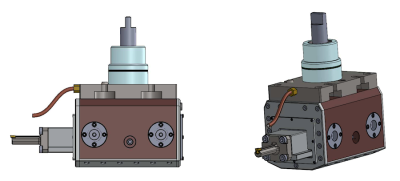
The REV motorized slotter is designed to solve, in the most efficient way, the problem of having to perform certain processing operations on a CNC lathe, from a simple keyway to internal or external toothed profiles.
The REV motorized slotter is designed to obtain maximum rigidity. This feature allows the insert to be used for a long time and the processed surface to have an excellent degree of finish.
There are remarkable advantages in using this slotter: in addition to its extremely fast processing speed, the piece does not need to be moved on other machines, thus avoiding further tool set-ups.
The REV motorised slotter has several adjustments, which are useful for achieving correct processing, and can perform internal or external processing.
The REV motorised slotter is protected by patent.
Advantages:
• Y- and Z-axis correction (patent protected aspect);
• Extreme rigidity, a characteristic that ensures an excellent degree of finish and, at the same time, a long life of the cutting edge of the insert; and
• Time saving, allowing to carry out the work in extremely fast times and avoiding, at the same time, the movement of the piece and the use of additional machine tools.
Contact Details
Related Glossary Terms
- computer numerical control ( CNC)
computer numerical control ( CNC)
Microprocessor-based controller dedicated to a machine tool that permits the creation or modification of parts. Programmed numerical control activates the machine’s servos and spindle drives and controls the various machining operations. See DNC, direct numerical control; NC, numerical control.
- lathe
lathe
Turning machine capable of sawing, milling, grinding, gear-cutting, drilling, reaming, boring, threading, facing, chamfering, grooving, knurling, spinning, parting, necking, taper-cutting, and cam- and eccentric-cutting, as well as step- and straight-turning. Comes in a variety of forms, ranging from manual to semiautomatic to fully automatic, with major types being engine lathes, turning and contouring lathes, turret lathes and numerical-control lathes. The engine lathe consists of a headstock and spindle, tailstock, bed, carriage (complete with apron) and cross slides. Features include gear- (speed) and feed-selector levers, toolpost, compound rest, lead screw and reversing lead screw, threading dial and rapid-traverse lever. Special lathe types include through-the-spindle, camshaft and crankshaft, brake drum and rotor, spinning and gun-barrel machines. Toolroom and bench lathes are used for precision work; the former for tool-and-die work and similar tasks, the latter for small workpieces (instruments, watches), normally without a power feed. Models are typically designated according to their “swing,” or the largest-diameter workpiece that can be rotated; bed length, or the distance between centers; and horsepower generated. See turning machine.
